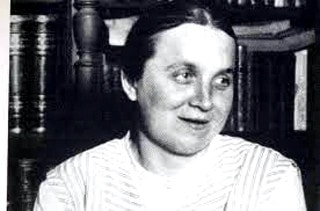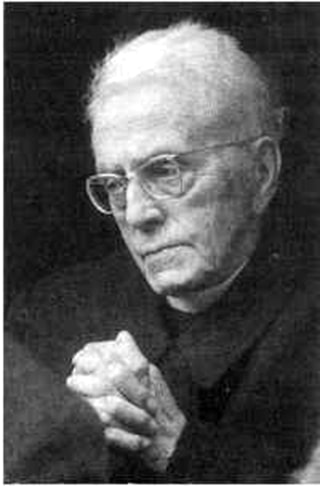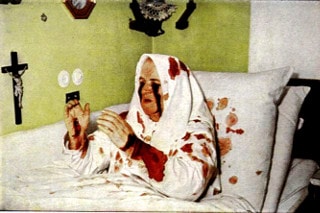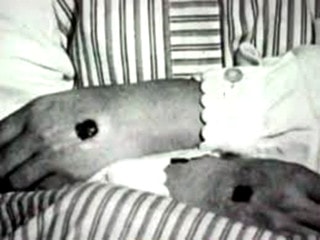 Servant of God, Theresa Neumann, was born on Good Friday, April 8, 1898, in the small village of Konnersreuth, Bavaria, Germany, and was the eldest of ten children. Interestingly, this also happens to have been the very year when St. Thérèse of Lisieux, the Little Flower, who later played such an important part in Theresa Neumann’s life, passed to her eternal reward.
Servant of God, Theresa Neumann, was born on Good Friday, April 8, 1898, in the small village of Konnersreuth, Bavaria, Germany, and was the eldest of ten children. Interestingly, this also happens to have been the very year when St. Thérèse of Lisieux, the Little Flower, who later played such an important part in Theresa Neumann’s life, passed to her eternal reward.
Theresa, whose parents nicknamed her “Resil”, was from a poor family who owned a small farm, the earnings of which were supplemented by Mr. Neumann’s income as a tailor. Theresa was sturdy and able to assist her parents in caring for her younger brothers and sisters. Her vital role in their rearing was especially necessary when her father was called into service during the First World War.
On Sunday, March 10,1918, a fire broke out in the barn of Martin Neumann, Therese’s uncle, for whom she was working. As part of a bucket brigade, she was lifting pails of water to someone higher up in the stable. After sustained exertion, she became utterly exhausted and fell to the floor. With very severe pains in her spine, and unable to walk alone, she needed to be helped to reach her nearby home.
The fall had caused partial paralysis of the spine, accompanied by very severe cramps in her legs. Physicians were called in to evaluate her, but they were unable to bring any relief to her serious condition which became worse every day. The physicians seemed powerless to help Theresa, nor to hold out any hope to her grieving family. Their sorrow reached a climax in March, 1919, when Theresa also became totally blind. Along with the pains in her legs and back, bedsores caused by her long confinement in this helpless condition added to her great sufferings.
Thus, a tremendous change had occurred in the life of Theresa Neumann. A short while ago she had been a strong and healthy girl, with the ability to work hard; now she found herself struck with partial paralysis — a burden to the very ones she would like so much to help. But it was during this time that her spiritual life blossomed and she offered herself up to the Most Sacred Heart of Jesus. She enjoyed spiritual reading, so her family members  took turns reading to her about Our Lord, the Blessed Mother, and the saints. The story of Thérèse, the Little Flower of Jesus, was one of her favorites.
took turns reading to her about Our Lord, the Blessed Mother, and the saints. The story of Thérèse, the Little Flower of Jesus, was one of her favorites.
Father Josef Naber, pastor since 1909 of the parish of St. Lawrence in Konnersreuth, had been Theresa’s spiritual director for nine years. He was a very devoted pastor, especially to those most in need of comfort. Theresa, perhaps the most afflicted of all the people in Konnersreuth, was graciously given a large measure of his paternal care and spiritual guidance. He was deeply impressed by the resignation with which Theresa bore her many sufferings.
After four years of suffering, a very joyful day was approaching for Theresa. Sunday, April 29, 1923 was the day scheduled for the beatification ceremonies in Rome of the Carmelite nun, the saintly Thérèse of Lisieux, who had promised before her death to let fall from Heaven a “shower of roses.” In Theresa’s bedroom, flowers were arranged to adorn the picture of the “Little Flower”, a gift from her father. Many days before she had begun a Novena in spiritual preparation for the day when the Little Flower would be officially numbered among the beatified. The day of the Beatification arrived and as the ceremonies at St. Peter’s in Rome were drawing to a close, the newly beatified Thérèse of Lisieux “showered a bouquet of roses” on her devoted sufferer; at the instant of beatification, Theresa found that her eyesight was completely restored.
On May 17, 1925, when Thérèse of Lisieux was canonized and became officially recognized as a saint of the Catholic Church, Theresa Neumann heard the saint’s voice, soft and distinct, “Theresa, do you not want to become well?”
Theresa answered her, ‘’Anything is all right with me: to be healthy, to remain sick, to die, whatever is the will of God.”
The voice continued, “Theresa, would it not cause you joy to receive some relief from your suffering, at least to be able to sit up and walk again?”
Theresa answered, “Anything that comes from God causes me joy.”
Again the voice said: “Theresa, I shall obtain for you a small joy. You shall now be able to sit up and to walk, but you will still have much to suffer. However, be not afraid; you have received help through me in the past and I will also help you in the future.”
As St Thérèse of Lisieux was speaking, it was as though two strong hands lifted Theresa from her bed, and after being paralyzed for six and one half years, she found herself completely healed. Not only was she healed of the paralysis, but of the gaping bedsores on her body as well.
These extraordinary graces inspired in Theresa Neumann a deep and most profound trust and confidence in God, which was very much needed in what was soon to come in her life.
 |
| Theresa in ecstasy during the Passion of Our Lord |
In February of 1926, Theresa fell ill with what was believed to be influenza. On the morning of the first Friday of Lent, March 5, 1926, she had a weak spell which forced her to stay in bed. Alone in her bedroom during most of these hours, she was in what seemed to be a state of semi-consciousness, but which was, at least in part, a divine ecstasy. As she lay on her bed, she suddenly saw the Divine Redeemer in the Garden of Gethsemani. “I saw Him kneeling on the ground, and I saw everything else in the garden, the trees, the rocks, and also the three disciples. They were not sleeping, but in a sitting position, leaning on a rock. They looked quite exhausted. All at once I felt such vehement pain in my side that I thought my last moment had come. Then I felt something running down my body. It was blood.” The blood kept on trickling until toward noon of the next day, and Resl remained so weak that she hardly knew where she was.
As the day went on, Theresa noticed that the left side of her nightgown was stained with blood. She found that the blood came from a wound slightly above her heart. The wound was the first of her stigmata and represented the place where the lance of Longinus penetrated the sacred body of Jesus.
On the night of the second Thursday of Lent, into the second Friday of Lent, March 12,1926, she had another bout of weakness and began feeling ill and was once again confined to her bed. During the early hours of Friday morning, she was rapt in a vision and saw the Saviour, first in the Garden of Olives and then at the pillar of scourging, and the wound in her side bled again. She decided to confide in her sister Creszentia.
On the third Friday of Lent, March 19, 1926, she saw in an ecstasy Christ in Gethsemani. He was crowned with thorns. Theresa’s side wound began bleeding once more. Then on Passion Friday (the Friday before Holy Week) March 26, 1926, she saw the Saviour carrying the wood of the cross and falling under its weight. The wound in her side bled again at this time and an open wound appeared on the back of Theresa’s left hand. This new wound could no longer be kept a secret, and nor could the wound she bore above her heart, as it began bleeding profusely.
On the night of Holy Thursday, April 2, 1926, Theresa saw in an ecstatic vision the complete Passion of Our Lord, from the Garden of Gethsemane up to His death on the Cross, beginning at about midnight on Holy Thursday, and ending with our Saviour’s death on the Cross at 3 p.m. on Good Friday afternoon. The suffering which came upon Theresa during those hours was so excruciating that words cannot describe it. From the additional wounds on her hands and feet, which were now all completely penetrating, blood flowed profusely, as it did from her eyes, rolling down both cheeks and collecting upon her throat and chest.
The sight of Theresa suffering on her bed in this pitiable condition was almost more than her family could stand. As the hours passed and her suffering increased, they realized that they were witnessing something of divine origin. Father Naber had intended to anoint Theresa, giving her the Sacrament of Extreme Unction (Last Rites of the Church), but at 3 p.m. that afternoon the ever-increasing, excruciating pain climaxed in a final death struggle. Then, abruptly, it all ended, and Theresa fell lifelessly back into her pillows, exhausted beyond the last ounce of her strength.
After a few hours, Theresa gradually returned to her normal physical condition. Her parents and Father Naber were so moved by what they saw that it was some time before they regained composure. After she had been washed up, Father Naber carefully observed that Theresa bore on the back of each hand and on the instep of her feet, “round, open wounds from which clear blood flows.” The wounds caused her intense pain; she said that the feeling was as if something “was sticking in there.” The side wound caused her great pain also, and in this wound the pain seemed to come from deep inside.
At the culmination of Holy Week, during the morning hours of Easter Sunday, 1926, Theresa had another ecstatic vision in which she saw the risen Christ, dressed in a white garment. From this time onwards, the sufferings of the Passion of Our Lord would be experienced by Theresa each week, usually beginning on Thursday evening and lasting until Friday afternoon.
On Friday, November 5, 1926, Theresa received nine wounds about her head from the Crowning of Thorns, and also wounds on her shoulders and back which represented her participation in the Scourging. From this point on, the wounds from the Crown of Thorns required her to constantly wear a head-cloth. Thus the stigmata on the body of Therese Neumann became complete, including the wound above her heart, penetrating wounds on her hands and feet, the nine wounds on her head, and the wounds on her shoulders and back. Not one of the wounds ever disappeared; they never healed, and they were still imprinted on her body at the time of her death.
On the anniversary of her death, September 30, 1927, St Thérèse of Lisieux appeared to Theresa in a vision and told her that henceforth she would live entirely on the Eucharist, and would have no need for earthly food. This total abstinence from food and drink continued until her death in 1962.
This led to a request by the Bishop of Regensburg that Theresa submit herself to a period of medical observation. Resl’s father agreed to comply with the episcopal request, and so from July 14 to 28 inclusive, in the year 1927, Theresa was under the observation of four Mollersdorfer Sisters, members of a nursing order, who came to her home. They were placed under oath by the Regensburg ordinariate before and after the observation. All were well qualified for the task, and carried out with the most scrupulous care the directions of Dr. Seidl, the medical supervisor.
The directions were very strict and carefully calculated to meet every possible contingency. Theresa was not to be left alone for a single moment, day or night, whether at home, in church, or out of doors. For this reason, even her customary confession was foregone.
Dr. Seidl, who had been Theresa’s attending physician since at least 1918, testified under oath in a Munich court case on April 15, 1929, that there could be no question of Theresa having taken any nourishment during the period of observation. He maintained flatly that the abstention of all nourishment by Theresa was a fact, which he had not the least reason to doubt. He added that since September, 1926, the stigmatist took no nourishment at all, not even a bit of water, as she had at the time of the fifteen days’ observation. Theresa was once asked how it was possible that she lived on the Eucharist alone, and she responded “The Saviour can do all things. Did He not say that 'My Flesh is real food, and my blood is real drink?'” (John 6:55)
Theresa was given many visions of Our Lord, and she also was shown many details of His earthly life, from His birth until His Resurrection. She was often visited by our Blessed Mother, the Saints and Angels. Theresa always recognized priests as priests, a particularly mysterious phenomenon which baffled many visitors. She explained that she was able to recognize any ordained priest by his “consecrated hands”. On occasion, especially during World War II, priests would come dressed as ordinary lay persons, and she would immediately recognize them, addressing them by saying “Hello Father”. She could also immediately tell the difference between consecrated and unconsecrated Hosts. She was able to recognized the presence of the Blessed Sacrament in a church as far away as one mile. When she approached the Blessed Sacrament — whether it was in the tabernacle of a Catholic Church, or carried on the person of a priest making a sick call — her wounds reflected this joy, and the pain subsided temporarily.
Another phenomenon was that only one thing would bring Theresa out of a Passion ecstasy momentarily, and that was the blessing of a Catholic priest (or bishop) who might be present. She would respond to the blessing with the words: “Thanks be to God, Father.” (or “your Excellency.”)
As a Victim Soul, Theresa suffered primarily for the souls of sinners. She obtained these conversions by her participation in the Passion in union with Jesus. At times she was “shown” for whom in particular she was suffering for. On other occasions, she took upon herself the physical sufferings of others, always of course, with the permission of God.
 Concerning her use of various languages in her ecstasies, Theresa was heard speaking in Hebrew, Greek, Aramaic, Portuguese, etc… It seemed that she was able to speak and understand whatever the native tongue of the one whom was appearing to her, for example the Hebrew, Greek and Aramaic of those of Jesus’ time, the Potuguese of St. Anthony of Padua, the Latin of St. Lawrence, and even the French dialect of the Pyrenees, in the vision of St Bernadette at Lourdes.
Concerning her use of various languages in her ecstasies, Theresa was heard speaking in Hebrew, Greek, Aramaic, Portuguese, etc… It seemed that she was able to speak and understand whatever the native tongue of the one whom was appearing to her, for example the Hebrew, Greek and Aramaic of those of Jesus’ time, the Potuguese of St. Anthony of Padua, the Latin of St. Lawrence, and even the French dialect of the Pyrenees, in the vision of St Bernadette at Lourdes.
In the late 1950’s Theresa began having heart troubles and as time when on, mild heart attacks. On the day of her death, she received the rare grace of a miraculous Communion, an event which usually happened only on high feastdays; the Host appeared on Theresa’s tongue, having been given her by Our Lord Himself. The time was 10:30 a.m. Theresa was fully conscious and able to ring for her sister Marie. She appeared to be very uncomfortable, and it was apparent that the death struggle was in progress. Marie was greatly alarmed and immediately called Father Naber. As he stepped into the room, Theresa had already presented her soul to her dear Lord and Saviour Jesus Christ. Thus on September 18, 1962, a great mystic and stigmatist passed to her eternal reward.
The process of Beatification and Canonization for Theresa Neumann was officially opened on February 13, 2005, by Bishop Gerhard Mueller of Regensburg, Germany, she is therefore officially considered a “Servant of God” by the Catholic Church.
| Gratitude for favours received through Theresa Neumann’s intercession, and prayer requests attributed or entrusted to her, should be reported to the Chairman of the Department for Beatification and Canonization Processes, Rev. Domvikar Georg Schwager, Schwarze-Bären-Str. 2, D-93047 Regensburg or Kath. Pfarramt, Kirchplatz 3, D-95692 Konnersreuth, Germany. |
Extracted from: http://www.mysticsofthechurch.com/2009/12/therese-neumann-mystic-victim-soul.html
with the kind permission of Glenn Dallaire